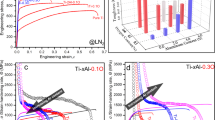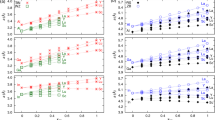Abstract
THE TiAl phase (ɛ) of the aluminium-titanium system exists as a single-phase field and can be achieved as a high-temperature phase without a polymorphic phase transformation. Results of an early investigation by the Armour Research Foundation indicated that an alloy of 36 per cent aluminium with 64 per cent titanium had superior oxidation resistance of 1,500°F, good hot hardness, and low density; however, it lacked any degree of room-temperature or elevated-temperature ductility1. The cause of this brittleness appeared to be the ordered face-centred tetragonal lattice structure, in which [002] planes of aluminium atoms were alternated with titanium atoms. It was assumed that if the c/a ratio could be reduced to unity, and the atomic arrangement could be disordered, the ductility of the ɛ, phase could be improved. Kessler and McAndrews1 tried to reduce the c/a ratio to unity by the additions of 13 different elements. Davies2 in 1959 suggested the addition of Zr as a means of reducing the c/a ratio. Sandlin and Klug3 and Troup4 continued to study the effect of Zr additions to the TiAl binary. The purpose of our investigation was to refine the 2,325° F ɛ-phase boundary of the Al-Ti-Zr system outlined by the earlier investigators and to determine the influence of zirconium on the c/a ratio within the ɛ phase at this temperature.
This is a preview of subscription content, access via your institution
Access options
Subscribe to this journal
Receive 51 print issues and online access
$199.00 per year
only $3.90 per issue
Buy this article
- Purchase on Springer Link
- Instant access to full article PDF
Prices may be subject to local taxes which are calculated during checkout
Similar content being viewed by others
References
Kessler, H. D., and McAndrews, J. B., WADC Tech. Report, 53–182 (1953).
Davies, F. C., thesis, United States Air Force Institute of Technology (1959).
Sandlin, D. R., and Klug, jun., H. A., thesis, United States Air Force Institute of Technology (1961).
Troup, D. H., thesis, United States Air Force Institute of Technology (1962).
Myers, E. J., and Davies, F. C., Acta Cryst., 14, 194 (1961).
Author information
Authors and Affiliations
Rights and permissions
About this article
Cite this article
SPRAGINS, S., MYERS, J. & SAXER, R. Influence of Zirconium Additions on the Epsilon Phase of the Titanium-Aluminium System. Nature 207, 183–184 (1965). https://doi.org/10.1038/207183a0
Issue Date:
DOI: https://doi.org/10.1038/207183a0
This article is cited by
-
Critical Assessment of the Al-Ti-Zr System
Journal of Phase Equilibria and Diffusion (2020)
Comments
By submitting a comment you agree to abide by our Terms and Community Guidelines. If you find something abusive or that does not comply with our terms or guidelines please flag it as inappropriate.



